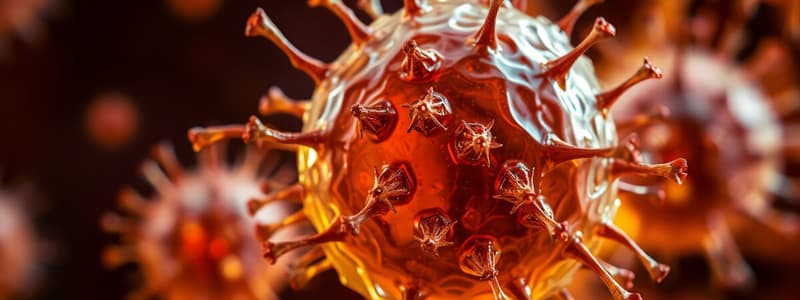Podcast
Questions and Answers
What characterizes the role of BH3 mimetics in apoptotic therapy?
What characterizes the role of BH3 mimetics in apoptotic therapy?
- They block anti-apoptotic proteins to induce apoptosis. (correct)
- They inhibit environmental inducers of autophagy.
- They directly activate receptors on the surface of cancer cells.
- They stimulate the intrinsic pathway to promote cell survival.
Which condition would most likely lead to a failure in autophagy, resulting in cell death?
Which condition would most likely lead to a failure in autophagy, resulting in cell death?
- Presence of LAMP-2A protein in lysosomal membranes.
- Accumulation of misfolded proteins. (correct)
- Accidental damage to lysosomal membranes.
- Regulated starvation of the cell.
Which type of autophagy involves the direct uptake of cytosolic components into lysosomes?
Which type of autophagy involves the direct uptake of cytosolic components into lysosomes?
- Chaperone-mediated autophagy
- Selective autophagy
- Microautophagy (correct)
- Macroautophagy
How does autophagy contribute to the survival of cancer cells under stress?
How does autophagy contribute to the survival of cancer cells under stress?
What is the effect of XIAP antagonists in apoptosis-based therapies?
What is the effect of XIAP antagonists in apoptosis-based therapies?
What is the primary role of the Bcl-2 family proteins in apoptosis?
What is the primary role of the Bcl-2 family proteins in apoptosis?
Which statement about the intrinsic pathway of apoptosis is true?
Which statement about the intrinsic pathway of apoptosis is true?
How does the extrinsic pathway induce apoptosis?
How does the extrinsic pathway induce apoptosis?
What is one method through which cancer cells can evade apoptosis?
What is one method through which cancer cells can evade apoptosis?
What is autophagy primarily responsible for in cellular processes?
What is autophagy primarily responsible for in cellular processes?
Which component is essential for forming an apoptosome during apoptosis?
Which component is essential for forming an apoptosome during apoptosis?
What is one characteristic feature of the process of apoptosis?
What is one characteristic feature of the process of apoptosis?
How is the process of autophagy regulated within cells?
How is the process of autophagy regulated within cells?
What role does phosphatidylserine play in apoptosis?
What role does phosphatidylserine play in apoptosis?
Which of the following is a target for apoptosis-based cancer therapies?
Which of the following is a target for apoptosis-based cancer therapies?
Flashcards are hidden until you start studying
Study Notes
Apoptosis
- Irreversible process that breaks down a cell from the inside out.
- DNA is fragmented due to cleavage between nucleosomes.
- Chromatin condenses and the nucleus breaks into pieces.
- Cytoskeleton breaks down.
- Cell shrinks and breaks into membrane-enclosed fragments (blebbing).
- Apoptotic cells are recognized and phagocytosed by macrophages and neighboring cells, facilitated by phosphatidylserine exposure.
Apoptosis Pathway Components
- Bcl-2 Family: Regulates apoptosis. Some members promote apoptosis (e.g., Bax, Bak), while others inhibit it (e.g., Bcl-2, Bcl-XL).
- Intrinsic Pathway: Activated by internal stimuli such as DNA damage.
- Cytochrome c is released from mitochondria.
- Apaf-1, ATP, and caspase-9 form a complex called the apoptosome.
- Caspase-9 is activated, initiating a caspase cascade.
- Extrinsic Pathway: Activated by external stimuli like death receptors.
- Fas ligand (FasL) binds to Fas receptor on the cell surface.
- FADD and pro-caspase-8 form a complex, activating caspase-8.
- Caspase-8 activates caspase-3, further amplifying the apoptotic cascade.
Apoptosis Regulation
- Positive Feedback Loops: Caspases activate downstream caspases.
- Buffers/Dampeners:
- Bcl-2 proteins: Inhibit apoptosis.
- IAPs (Inhibitors of Apoptosis Proteins): Prevent activation of procaspases and inhibit caspase activity.
- Smac/DIABLO: Inhibits IAPs.
- FLIP (FLICE-like Inhibitory Protein): Competes with caspase-8 for binding to FADD and inhibits apoptosis.
- Decoy Receptors: Bind to apoptosis-inducing ligands but cannot transduce the apoptotic signal.
- p53: Tumor suppressor protein that can mediate cell cycle arrest and apoptosis.
- DNA damage activates ATM and Chk2 protein kinases, leading to p53 phosphorylation and stabilization.
- Activated p53 initiates transcription of pro-apoptotic genes (e.g., PUMA, Noxa).
Autophagy
- Definition: A regulated process of delivering cytosolic components and organelles to lysosomes for degradation and recycling.
- Inducers:
- Environmental cues: Starvation, high temperature, low oxygen, hormonal stimulation.
- Intracellular stress: Damaged organelles, accumulation of misfolded proteins, microbial and viral infections.
- Lysosomes: Degrade cytoplasmic material using enzymes to digest nucleic acids, proteins, carbohydrates, and lipids.
- Constituent macromolecules are released back into the cytosol for reuse.
- Types:
- Microautophagy: Cytosolic components directly taken up by the lysosome.
- Macroautophagy: Cytosolic components are delivered to the lysosome via autophagosomes (vesicles). Autophagosomes fuse with lysosomes to form autolysosomes.
- Chaperone-mediated autophagy: Targeted proteins are translocated across the lysosomal membrane bound to chaperone proteins, recognized by a receptor (LAMP-2A).
Autophagy Regulation
- Macroautophagy: Regulated during autophagosome formation.
- Chaperone-mediated autophagy: Mediated by levels of LAMP-2A protein in the lysosomal membrane.
Autophagy and Disease
- Neurodegenerative Diseases: Parkinson's, Alzheimer's, and Huntington's diseases.
- Characterized by the accumulation of aberrant or misfolded proteins that are not removed by autophagy.
- Cancer:
- Depends on the level of autophagy.
- Can help tumors survive stresses (e.g., hypoxia, nutrient deprivation).
Apoptosis and Disease
-
Excessive/Inappropriate Apoptosis:
- Neurodegenerative diseases
- Immune deficiency diseases
- Cardiovascular disease
- Emphysema
- AIDS
-
Too Little Apoptosis:
- Cancer
- Autoimmune Diseases
-
Apoptosis and Cancer:
- Cancer cells often evade apoptosis, often due to increased expression of IAPs and anti-apoptotic Bcl-2 proteins.
- Reactivating apoptosis is a target of cancer treatment strategies.
Studying That Suits You
Use AI to generate personalized quizzes and flashcards to suit your learning preferences.



